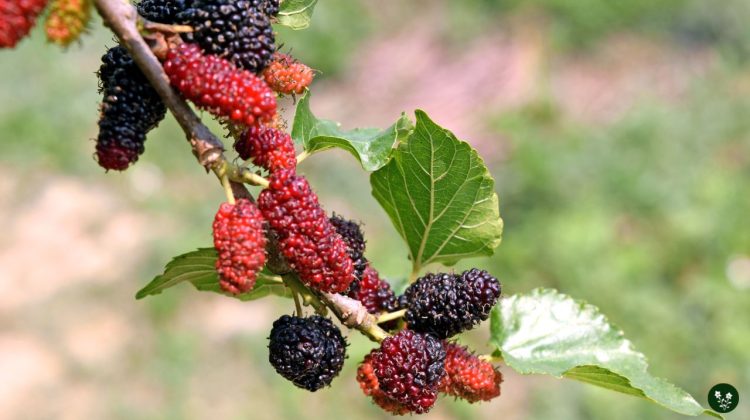
Mulberry trees are a delightful addition to your landscape, offering visual appeal and delicious fruits reminiscent of blackberries.
These medium-sized deciduous trees are available in red mulberry (Morus rubra) and white mulberry (Morus alba) varieties native to North America.
You’ll appreciate their dark green, serrated leaves and the tasty, albeit messy, berries they produce.
As you consider growing a mulberry tree in your garden, remember that these trees thrive in temperate regions of Asia and North America.
Whether you’re interested in their fruit or simply as an ornamental addition, mulberry trees can be a rewarding plant to nurture.
Their importance extends beyond their beauty and fruit production, as they serve as a vital food source for silkworms.
To cultivate a mulberry tree, consider soil type, watering, and climate preferences to ensure its healthy growth.
With proper care, you’ll enjoy their large heart-shaped green leaves, unique bark, and gnarled appearance as the tree grows and flourishes in your outdoor space.
In this article, we'll cover
1. Overview of Mulberry Trees
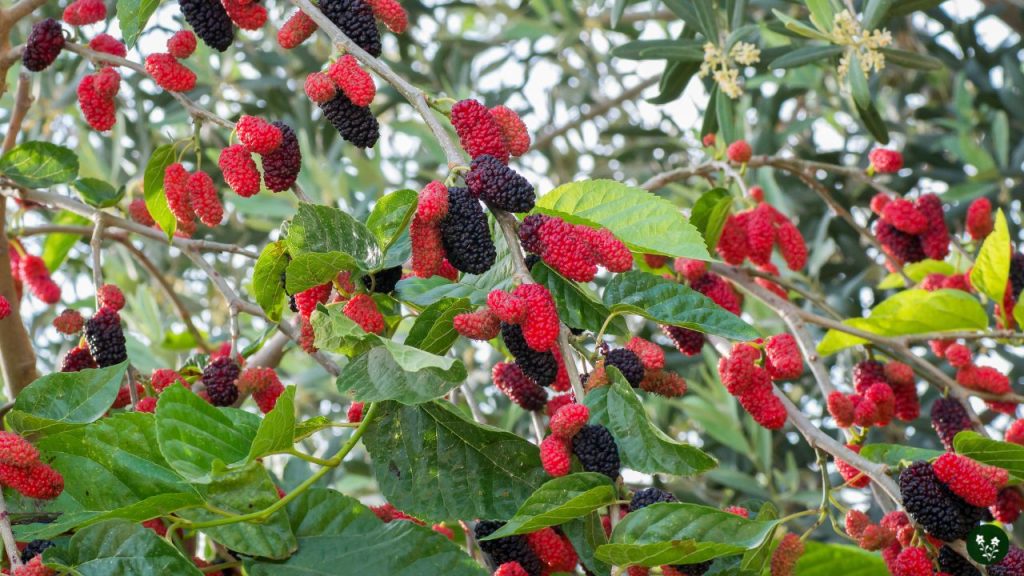
Genus Morus
Mulberry trees belong to the genus Morus and are medium-sized deciduous trees known for their delicious, small, and juicy berries reminiscent of blackberries.
The genus Morus consists of several species, with the most common ones being Morus nigra, Morus alba, and Morus rubra.
Black Mulberry (Morus Nigra)
The black mulberry, Morus nigra, is a deciduous tree famous for its delightful summer fruits.
Its large heart-shaped green leaves, ridged and flaking bark, and attractive, gnarled shape contribute to its aesthetics throughout spring, summer, and autumn.
The twisted appearance of the tree enhances the beauty of any garden or landscape.
- Sun and shade: Black mulberries perform well in full sun or partial shade.
- Soil: They prefer well-draining, moist, loamy soil with a pH between 5.5-7.
White Mulberry (Morus Alba)
White mulberry, Morus alba, is another common species native to China but is now widespread across North America.
This species features dark green leaves with serrated edges and produces a fruit that tends to be safer and less messy than the black mulberry.
- Sun and Shade: White mulberry trees thrive in full sun or partial shade.
- Soil: They prefer well-draining, moist, loamy soil but can tolerate various soil types.
Red Mulberry (Morus Rubra)
The red mulberry, Morus rubra, is native to eastern North America and is the largest species within the Morus genus.
It can often grow up to 70 feet tall, with two-lobed, three-lobed, or unlobed leaves and dark purple edible fruits.
- Sun and shade: Red mulberries thrive in full sun or partial shade.
- Soil: They prefer well-draining, moist, loamy soil with a pH between 5.5-7.
2. Growing Mulberry Trees

Choosing the Right Variety
When selecting a mulberry tree for your garden, consider factors like your local climate, available space, and intended use.
Do you want to enjoy delicious mulberry fruits, make jams, or appreciate the tree’s beauty?
Pick a variety that suits your needs and will grow well in your area.
Some popular options include the native black mulberry, the versatile white mulberry, and the compact Charlotte Russe.
Cultivation and Planting
To give your mulberry tree the best chance to thrive, follow these planting guidelines:
- Plant in early spring, when the weather is cool.
- Choose a sunny or partially shaded location.
- Ensure your soil is fertile, moist, and well-drained. Mulberries prefer a pH between 5.5 and 6.5.
- Space your trees 20-25 feet apart for traditional varieties or 10 feet for dwarf types.
Dig a hole at least twice the size of the root ball and gently place the tree into it.
Fill the hole with soil, making sure to remove any air pockets. Water thoroughly, and add a layer of mulch to help retain moisture.
Pruning and Maintenance
For healthy and productive mulberry trees, proper pruning and maintenance are essential:
- Prune young trees to establish a strong structure and encourage branching.
- Remove any dead, diseased, or damaged branches annually.
- Keep the tree’s canopy open to sunlight and air circulation.
- Consider cutting back long branches to encourage fruiting.
Water your mulberry tree regularly during dry spells, especially in the first two to three years as it becomes established.
Pest and Disease Management
Mulberry trees are generally hardy and resistant to most pests and diseases.
However, monitoring your tree for signs of issues like powdery mildew, leaf spots, or fruit fly infestations is crucial.
To reduce the likelihood of problems, practice good garden hygiene by cleaning up fallen fruit and leaves.
If you notice signs of pests or diseases, consult a local nursery or gardening expert for appropriate treatments.
By following these guidelines and watching your mulberry tree, you’ll be well on your way to enjoying its lovely flowers, tasty fruits, and lush foliage for years to come.
3. Silkworms and Mulberry Trees
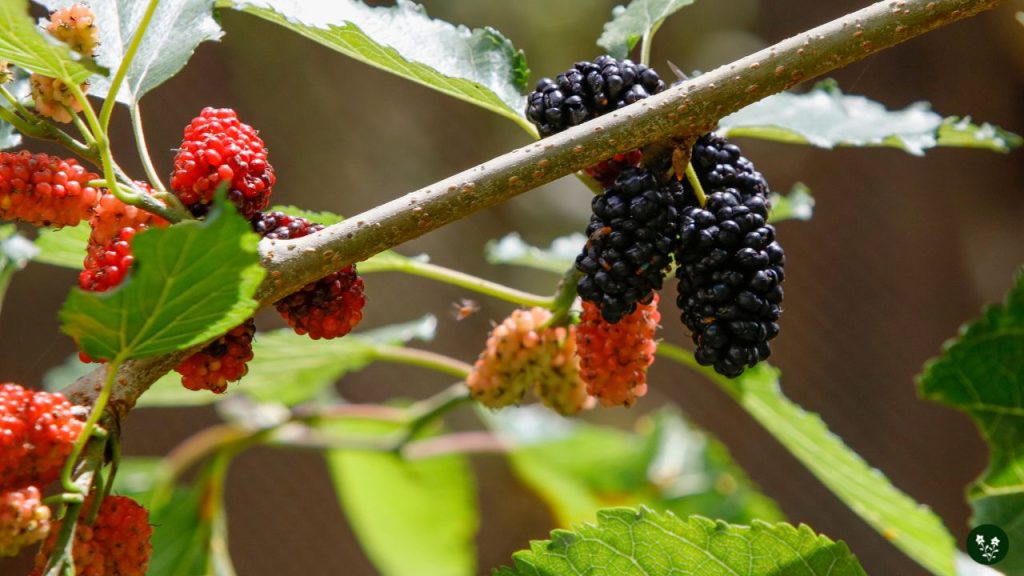
When it comes to raising silkworms, mulberry trees play a vital role.
The leaves of this tree are the primary and essential food source for silkworms, making them indispensable in the sericulture industry.
The white mulberry tree, native to China, has been the main food source for silkworms for almost 5,000 years.
Now you may find white mulberries naturalized in much of the United States.
There are three notable species of mulberry trees: red, white, and black. Ideally, silkworms prefer to munch on white mulberry leaves.
Although the quality of silk can be affected if they consume other types of mulberry leaves, silkworms will still feed on all varieties of mulberry leaves.
Let’s explore the relationship between commercial silkworm farming and mulberry trees:
- Mulberry cultivation: For a successful silkworm farm, you need easy access to a good supply of mulberry leaves. Therefore, commercial silkworm farms often cultivate their mulberry trees to optimize efficiency.
- Pest control: Watch for pests that might damage your mulberry leaves, as this can impact the health of your silkworms. You must be careful when choosing pest control options, as harsh chemicals can harm silkworms.
- Harvesting leaves: When harvesting mulberry leaves for your silkworms, select the young leaves with the best nutritional content. Usually, these are situated towards the tips of the branches.
- Feeding schedule: Silkworms have a voracious appetite, and feeding them enough mulberry leaves is key for survival. You may notice your silkworms eating more during certain times of the day. Adjust your feeding schedule as necessary to accommodate their needs.
As a silkworm farmer, nurturing a relationship between these small creatures and their primary food source, the mulberry tree, is essential.
Pay close attention to the quality and quantity of mulberry leaves you to supply, as this will directly impact the health of your silkworms and the quality of silk they produce.
4. Uses of Mulberry Fruits
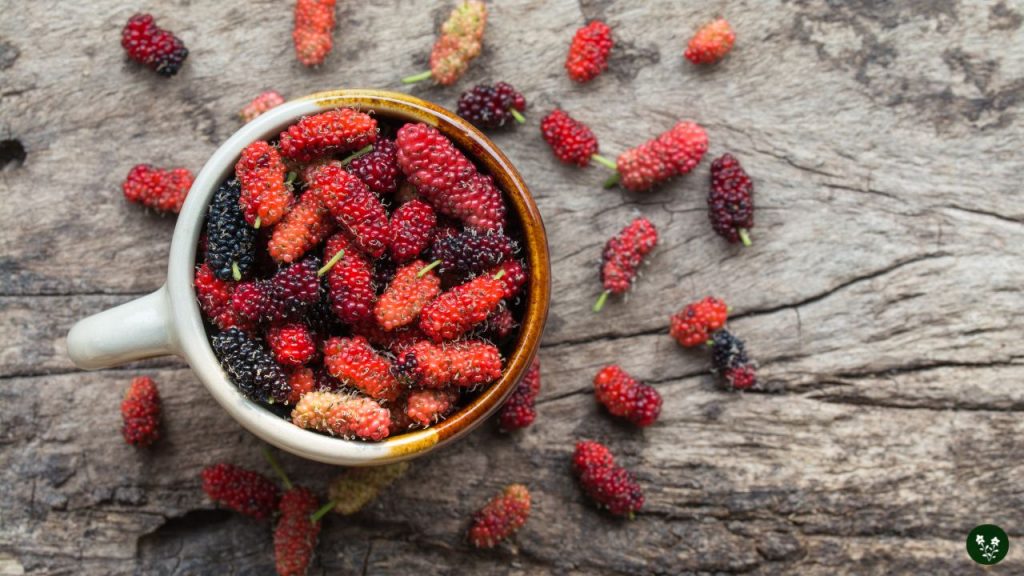
Making Jam and Wine
You can make delicious jam and wine using berries from the mulberry tree. Both black mulberry (Morus nigra) and white mulberry (Morus alba) fruits are suitable for these purposes.
Jam made from fresh mulberries is a great addition to your breakfast, whereas mulberry wine, prepared in September when the berries are ripe, can be a unique and tasty choice during gatherings with friends and family.
Mulberry Tea
The leaves of the mulberry tree also offer benefits. You can use them to make mulberry tea, a pleasant and soothing drink consumed for centuries in traditional medicine.
Dried or fresh leaves from black and white mulberry trees can be used to prepare the tea at your home.
Nutritional Benefits
Mulberries are not just flavorful, they also provide significant nutritional benefits.
Here’s a quick breakdown of the nutrients found in a cup (140 grams) of fresh mulberries:
| Nutrient | Amount |
|---|---|
| Water | 88% |
| Calories | 60 |
| Carbohydrates | 9.8% |
| Fiber | 1.7% |
| Protein | 1.4% |
| Fat | 0.4% |
These berries contain vitamins, minerals, and antioxidants, including anthocyanins and rutin, which help slow down the aging process, lower blood pressure, and protect your eyes.
Moreover, the fiber content in mulberries promotes digestive health, treats constipation, and aids in weight loss.
Enjoying mulberries as part of your regular diet can be a flavorful and nutritious way to support your overall well-being.
You can cultivate mulberry trees in your garden for a readily available supply of these delicious fruits and leaves for various uses in your home.
5. Allergies and Precautions
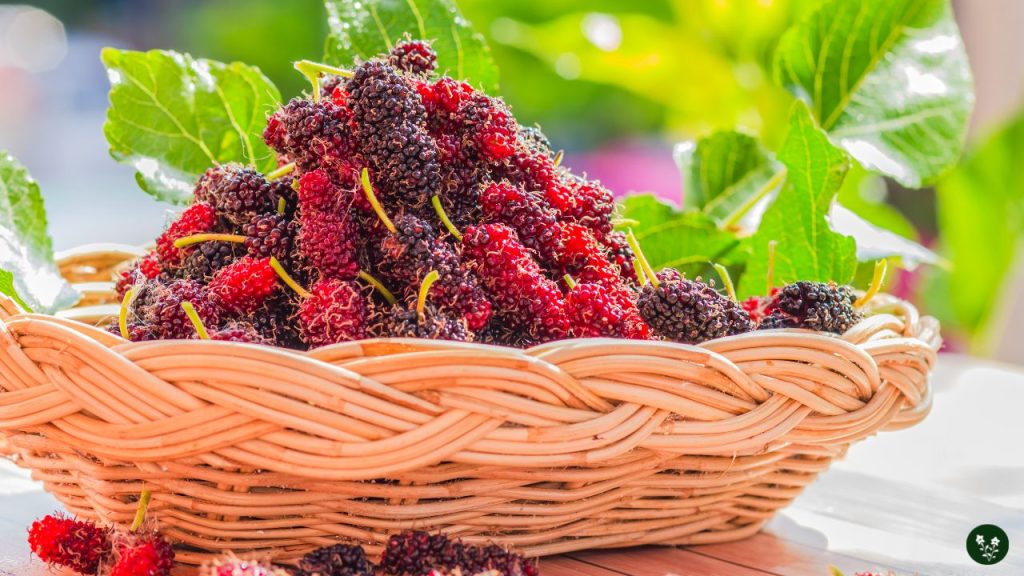
Mulberry trees, although known for their flavorful berries and leaves with health benefits, can also cause allergies in some individuals.
If you experience symptoms that worsen during the mulberry tree pollen season, you must be aware of the possible allergies and precautions you can take.
Some common mulberry tree allergy symptoms resemble those of other pollen allergies and may include:
- Sneezing
- Nasal congestion
- Runny nose
- Watery eyes
- Itchy throat and eyes
- Wheezing
If you have pre-existing asthma and are sensitized to mulberry trees, tree pollen may trigger or worsen your asthma symptoms, such as coughing and wheezing.
To help alleviate or avoid these allergy symptoms, consider the following precautions:
- Stay updated on the pollen count in your area and limit outdoor activities when pollen counts are high.
- Keep windows and doors closed during high pollen count days to reduce exposure to allergens indoors.
- If you need to be outside during peak pollen times, wearing a mask can help filter out allergens.
- Showering and changing clothes after spending time outside can help remove settled pollen from your body and clothing, reducing the chance of exposure while indoors.
By being informed about mulberry tree allergies and taking the necessary precautions, you can better manage your allergy symptoms and enjoy the many benefits mulberry trees can provide.
You may also like:
I have planted 4 mulberry trees, so called hardy varieties. They’ve grown well but have tiny tasteless berries. They have plenty of space and sun and are mulched, though not 2′. What do I need to do?
Three clusters of mulberry trees, a total of 7 trees, came up from seed against my garden fence ten years ago. Together they are 10 feet apart. This summer they reached 30 feet tall. I didn’t know what they were until they started fruiting a few summers ago, but this summer finally decided to look into what to do with them. I had no idea they were supposed to be separated.
I removed one cluster this week. I have two clusters left, and am having trouble deciding between them.
The center cluster is standing straight up but has only 2 trees. The cluster of 3 trees that I would rather save contains a leaning tree at the end. Over time, if I save this cluster, will this tree fall over?
At the top, the branches of both clusters appear to be interdependent at the moment. I am also concerned that if I remove the second cluster, the remaining cluster will be weak and the branches may break.
Did I wait too long to separate these clusters? Should I just leave the remaking two clusters? Will the third cluster survive if I remove the second one? Should I choose the cluster with 2 trees or 3?